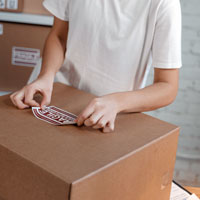How to Mark and Label a Package with Dangerous Goods
 A package that contains dangerous goods must have proper markings and labels to prevent safety hazards. If you don’t mark and label your dangerous good shipment, it may result in delays in transit and even fines. Let us give you a few tips on marking and labeling dangerous goods shipments.
A package that contains dangerous goods must have proper markings and labels to prevent safety hazards. If you don’t mark and label your dangerous good shipment, it may result in delays in transit and even fines. Let us give you a few tips on marking and labeling dangerous goods shipments.
Know the Difference Between Markings and Labels
Markings identify the design, specifications, and peculiarities of handling a particular package. They may include the UN certification safety mark, the UN number, the Proper Shipping Name (PSN) and technical name, net quantity, special hazard warnings (“marine pollution”, “biohazard”, etc.), shipper and consignee information, orientation and handling markings (“this way up”, “handle with care”, “keep away from heat”, etc.).
Dangerous goods labels are more specific markers that identify the type of hazard. There are nine classes of dangerous goods: explosives, gases, flammable liquids, flammable solids, oxidizing substances and organic peroxides, poisons and infectious substances, radioactive materials, corrosives, and miscellaneous hazardous materials. Each class has a set of labels in a specific color.
Place All Markings and Labels on One Side of the Package
All markings and labels, including the shipping label with address information, must be located on the same side of the package to be easily identifiable. If they don’t fit on one side, you need to get a bigger box and fill the empty space inside the box with cushioning material to keep the contents from moving around while in transit.
Orientation markings (arrow labels) are the only exception to the rule. In fact, when such markings are required (for example, when the shipment contains liquids), it is advisable to put two arrow labels on the opposite sides of the box.
Make Sure All the Markings and Labels Are Placed Correctly and Clearly Visible
The dangerous goods markings and labels must not wrap around the edges of the box, overlap, or be covered or obscured by any packing tape, document pouches, or text. Some dangerous goods markings may be printed directly onto the box. If this is your case, make sure to keep them clear from any stickers and tape.
Dangerous goods labels are usually diamond-shaped for ease of identification. When placing them on the box, you need to make sure they are affixed at an angle of 45°. The dangerous good label must be located within six inches of the marking containing the PSN (Proper Shipping Name). If there are multiple hazard labels, they must be affixed adjacent to each other without overlapping.
Securely Affix the Shipping Label and Shipper’s Declaration for Dangerous Goods
If the shipping label isn’t self-adhesive (this may be the case when you print your shipping labels yourself on regular paper), you need to protect it from the elements by putting it in a clear address pouch. Make sure to securely affix the shipping label to the box with clear packing tape so that it doesn’t cover other labels and markings. It’s also a good idea to print an extra copy of the shipping label and place it inside the box just in case.
If your shipment requires a shipper’s declaration for dangerous goods, you should treat it the same way as the shipping label, i. e. put it in a pouch and attach it to the box.
Check With Your Carrier
Although the general rules for marking and labeling packages containing dangerous goods are the same, shipping documentation and requirements may slightly vary between different shipping carriers. In additions, shipping rules and regulations may depend on the country you’re shipping from and the destination country. So we recommend to check with your carrier before packing and shipping to make sure you’re doing everything right because authorities do not treat any mistakes regarding dangerous shipments lightly.